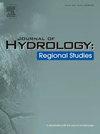基于混合深度学习模型的塔克拉玛干沙漠绿洲日参考蒸散量多步预测
IF 5
2区 地球科学
Q1 WATER RESOURCES
引用次数: 0
摘要
研究区域:中国新疆南部塔克拉玛干沙漠绿洲是世界上最具水文挑战性和气候极端的农业区之一。在这项研究中,我们使用六种先进的混合深度学习模型——lstm、BiLSTM、CNN-LSTM、CNN-BiLSTM、CNN-LSTM- attention和CNN-BiLSTM- attention来解决每日参考蒸散(ET0)的短期预测问题。利用了25个站点收集的历史日气象数据,其中1991年至2020年的记录用于模型训练,2021年至2023年的数据专门用于独立测试。对1天、3天和5天的交货时间进行了预测。采用全局性能指数(GPI)评价模型性能,采用Shapley加性解释(SHAP)分析不同气候条件下的特征贡献,进一步提高了模型的可解释性。基于区域bilstm的模型比基于长短期记忆网络(LSTM)的模型具有更高的ET0预测精度,而卷积神经网络(CNN)和注意力机制的结合进一步提高了预测性能。CNN-BiLSTM-Attention模型在不同台站和预测视界上均表现出最高的精度和鲁棒性,最适合沙漠绿洲地区的业务部署。SHAP分析表明,温度和太阳辐射是大部分站点蒸散发的主要驱动因子,其特征重要性的空间异质性突出。因此,本研究提供了稳健且可解释的ET0预测模型以及新的水文见解,为本地化水资源管理提供了实际支持,并增强了在超干旱农业系统中部署精确灌溉模型的信心。本文章由计算机程序翻译,如有差异,请以英文原文为准。
Multi-step-ahead forecasting of daily reference evapotranspiration using hybrid deep learning models for the Taklamakan Desert oasis
Study region
This research focuses on the Taklamakan Desert oasis in southern Xinjiang, China, which represents one of the most hydrologically challenging and climatically extreme agricultural regions in the world.
Study focus
In this study, we address the short-term forecasting of daily reference evapotranspiration (ET0) using six advanced hybrid deep learning models—LSTM, BiLSTM, CNN-LSTM, CNN-BiLSTM, CNN-LSTM-Attention, and CNN-BiLSTM-Attention. Historical daily meteorological data collected from 25 stations were utilized, with records from 1991 to 2020 used for model training and data from 2021 to 2023 reserved exclusively for independent testing. Forecasts were produced for 1-, 3-, and 5-day lead times. Model performance was evaluated using the Global Performance Index (GPI), and interpretability was further enhanced by applying Shapley Additive Explanations (SHAP) to analyze feature contributions under different climatic conditions.
New hydrological insight for the region
BiLSTM-based models demonstrated higher ET0 forecasting accuracy than long short-term memory networks (LSTM)-based models, while the incorporation of convolutional neural networks (CNN) and attention mechanisms further improved forecasting performance. The CNN-BiLSTM-Attention model consistently exhibited the highest accuracy and robustness across different stations and forecast horizons, making it the most suitable for operational deployment in desert oasis regions. SHAP analysis indicated that temperature and solar radiation are the principal drivers of ET0 at most stations, highlighting the spatial heterogeneity in feature importance. Thus, this study provides robust and interpretable ET0 forecasting models along with new hydrological insights, offering practical support for localized water resource management and enhancing confidence in the deployment of precision irrigation models in hyper-arid agricultural systems.
求助全文
通过发布文献求助,成功后即可免费获取论文全文。
去求助
来源期刊

Journal of Hydrology-Regional Studies
Earth and Planetary Sciences-Earth and Planetary Sciences (miscellaneous)
CiteScore
6.70
自引率
8.50%
发文量
284
审稿时长
60 days
期刊介绍:
Journal of Hydrology: Regional Studies publishes original research papers enhancing the science of hydrology and aiming at region-specific problems, past and future conditions, analysis, review and solutions. The journal particularly welcomes research papers that deliver new insights into region-specific hydrological processes and responses to changing conditions, as well as contributions that incorporate interdisciplinarity and translational science.
 求助内容:
求助内容: 应助结果提醒方式:
应助结果提醒方式:


